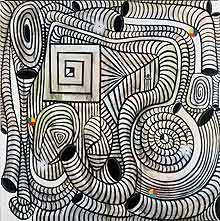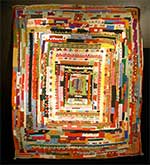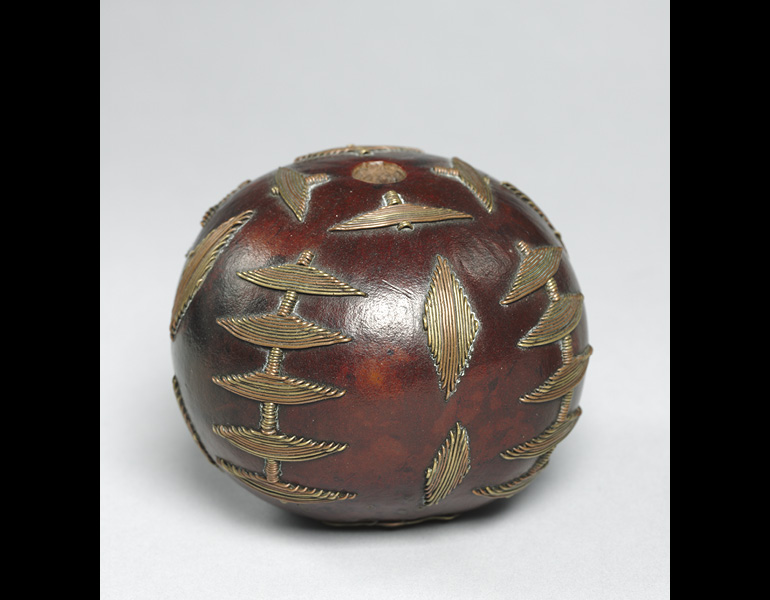
by Sandy | Jul 30, 2011 | Art, Arts, Entertainment and Music, Blogroll, Culture, Exhibits, Museums
 This month the Newark Museum opened a dynamic exhibition addressing the mix and richness of Cuban art- The Ajiaco: Stirrings of the Cuban Soul.
This month the Newark Museum opened a dynamic exhibition addressing the mix and richness of Cuban art- The Ajiaco: Stirrings of the Cuban Soul.
“In 1939, anthropologist Fernando Ortiz characterized Cuban culture as ajiaco, a rich stew consisting of a large variety of ingredients. The ingredients of the “stew” include Catholicism brought in by the Spaniards; the spirituality of the Yoruba slaves and their cultural traditions from Africa; and the Chinese indentured servants who brought Buddhism, Confucianism, and Taoism. The base of the stew is the indigenous people, such as Tainos, who were almost wiped out by the Spaniards. “
The Ajiaco: Stirrings of the Cuban Soul – Until 8/14/11
The Newark Museum
49 Washington Street, Newark, NJ
Images: El Artista (The Artist), Luis Cruz Azaceta (b. 1942) and Se Alimenta mi Espíritu (My Soul is Nourished), Manuel Mendive (b. 1944)

by Bob Martin | Jul 28, 2011 | Art, Culture

Photo by Robert Capra
We should thank Photo Journalists and others for preserving reality for us. The reality of what life is really like for the majority of people on the planet is  difficult to comprehend, especially for those of us who live on the outer fringe.
difficult to comprehend, especially for those of us who live on the outer fringe.
For almost seventy years citizens of the United States experienced themselves as living on the edge and outside of the “fishbowl” looking inward, with occasional concern for the fish in bowl. Earthquakes, floods and other disasters would catch our attention, but it was always someone else’s problem and we would dump money on it like it was water and we were putting out a fire.
 In the last ten years we’ve begun to slip into the reality of the rest of the world (our feet are wet) and find it difficult to hide behind Lindsay Lohan’s incarceration or Tiger Woods’ overindulgence and we can hear the utter fear in peoples voices and on their faces as their reality inches closer and closer to that of the rest of the world.
In the last ten years we’ve begun to slip into the reality of the rest of the world (our feet are wet) and find it difficult to hide behind Lindsay Lohan’s incarceration or Tiger Woods’ overindulgence and we can hear the utter fear in peoples voices and on their faces as their reality inches closer and closer to that of the rest of the world.
[ad#Adsense Link Unit]
[ad#Google Mobile]

by Sandy | Jul 25, 2011 | Art, Blogroll, Culture, Exhibits, Museums
 You may have guessed that I really like quilts. (I post about their exhibitions frequently.) I consider quilting an art form. These coverings, also used as wall hangings, are not only colorful, but often tell stories, family history, etc. Quilts can be comforting to the body, the eye and the soul.
You may have guessed that I really like quilts. (I post about their exhibitions frequently.) I consider quilting an art form. These coverings, also used as wall hangings, are not only colorful, but often tell stories, family history, etc. Quilts can be comforting to the body, the eye and the soul.
MoAD/ Museum of the African Diaspora in San Francisco, CA presents: “Soulful Stitching: Patchwork Quilts by Africans (Siddis) in India”. This is an introduction to a little known people (at least to me) and their quilt tradition called “Kowandi”.
Featured are “32 striking patchwork quilts made by Siddi women, heirs to the culture and values of Africans brought to Goa on India’s west coast beginning in the 16th century. While they have adopted and integrated many cultural aspects of the Indian peoples with whom they have lived for generations, Siddis have also retained and transformed certain cultural and artistic traditions from Africa”.
Soulful Stitching: Patchwork Quilts by Africans (Siddis) in India – Until September 18, 2011
Museum of the African Diaspora/ MoAD
685 Mission Street San Francisco, CA
by Sandy | Jul 15, 2011 | Blogroll, Culture, Education, Exhibits, Film, Museums
The weekend long festivities for the grand opening of The New African-American Civil War Memorial and Museum in Washington, DC begins on Saturday July 16, 2011. 
“Using photographs, documents and state of the art audio visual equipment, the museum helps visitors understand the African American’s heroic and largely unknown struggle for freedom. The museum is located two blocks west of the Memorial in the historic U street corridor. To assist visitors, researchers, and descendants of USCT, the Museum also offers important educational and research tools.”
Joining in the celebration will be local dignitaries, with speeches of course, panel discussions and an all day film festival on Sunday July 17. A few of the films showing are listed below:
The Freedom Riders
Glory
Eyes on the Prize
For Love of Liberty
The New African-American Civil War Memorial and Museum
1925 Vermont Avenue. NW Washington, DC
by Sandy | Jun 13, 2011 | Art, Blogroll, Culture, Exhibits, Museums
Examples of Romare Bearden’s graphic art will be highlighted at the Museum of the African Diaspora in San Francisco, CA . 
“From Process to Print: Graphic Works by Romare Bearden” will be just one of many presentations planned around the country to acknowledge the artist’s centennial. “It’s an exhibition honoring Romare Bearden’s remarkable versatility as an artist and his mastery of the print medium. The works in this exhibition show Bearden’s extra-ordinary facility for weaving into every art form a rich tapestry of literary, biblical, mythological, popular culture and western and non-western themes that were informed by his African American cultural experiences. Bearden incorporated into his art work a rich montage of influences from American, African, Asian and European art and culture and took inspiration from memories and experiences of the rural South, the urban North and the Caribbean.”
From Process to Print: Graphic Works by Romare Bearden – 7/3/11
MoAD – The Museum of the African Diaspora
685 Mission Street San Francisco, CA

by Sandy | Jun 9, 2011 | Art, Blogroll, Culture, Museums
The Cleveland Museum of Art currently has an exhibit of canes, bowls, snuff boxes, etc. representing private, useful, personal objects that are also art: 
The Art of Daily Life: Portable Objects from Southeast Africa “celebrates the stunning formal diversity and deep cultural meanings of Southeast Africa’s artistic heritage. Despite some growing interest and appreciation over the past three decades, the art of traditional southern African societies have long been neglected. Portable in nature and generally small in size, works created by peoples such as the Zulu, Nguni, Tsonga, Ndebele, Sotho, and Swazi in the 19th and 20th centuries were typically related to the privacy of the home or the intimacy of the person. The makers and users of many of these works were cattle-herders with a complex history of migrations. This nomadic existence has contributed to the emergence of fluid regional artistic styles that often defy specific ethnic attributions.”
The Art of Daily Life: Portable Objects from Southeast Africa
The Cleveland Museum of Art, 11150 East Boulevard, Cleveland, Ohio
(Images- items from 1800s—1900s: Snuff Container (South Africa, Zulu people or Northern Nguni people, Gourd, copper and brass wire) and Staff (the Baboon Master ,South Africa, Tsonga people, Wood)

 This month the Newark Museum opened a dynamic exhibition addressing the mix and richness of Cuban art- The Ajiaco: Stirrings of the Cuban Soul.
This month the Newark Museum opened a dynamic exhibition addressing the mix and richness of Cuban art- The Ajiaco: Stirrings of the Cuban Soul. 









